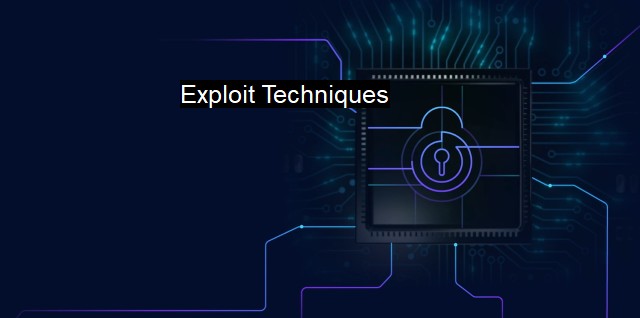What are Exploit Techniques?
The Menace of Exploit Techniques: Understanding the Threat and Safeguarding Your Cybersecurity and Antivirus Systems
Exploit techniques refer to a myriad of strategies employed by cyber attackers to take advantage of various software and system vulnerabilities. These techniques are continually evolving, driven by relentless advancement in technology, and contribute significantly to the severity and intensity of cybersecurity challenges.An exploit, in cybersecurity terms, is a piece of software, a string of data, or a series of commands that are able to take advantage of system vulnerability to facilitate an unauthorized function or behavior. Exploit techniques encompass all the practice of identifying, developing, and applying these exploits to compromise the security of data, networks, or resources.
Exploit techniques have been given a lot of weightage due to the potential risks and damages they present. Bogging down systems, having unauthorized access to data, interrupting network connections, and altering or locking information - all of these courses and much more; can be effectively realized through the adept application of exploit techniques.
In the context of this discussion, three primary categorizations of exploit techniques can be distinctly observed, namely, software exploits, network exploits and social engineering exploits.
Software exploits take on vulnerabilities that grow out of errors and bugs in the code or architecture of the software or operating system. Unpatched or outdated software can be a commonplace for such vulnerabilities. Buffer overflow exploits, injection exploits and backdoor exploits are some of the many types of software exploits.
Buffer overflow exploits pertain to situations where an oversized data input overloads the buffer storage causing data leakage, corruption, or a complete system crash. Injection exploits usually involve an attacker populating a software with malicious codes or scripts which once executed, compromise the software or severs. Backdoor exploits, on the other hand, rely on the unintentional or intentional loopholes coded into the software for maintenance or ease access, which are then exploited for malicious intent.
Network exploits primarily focus on the vulnerabilities found in the infrastructure of communication networks or security protocols. Often network exploits can crack open user credentials, handshake protocols, or security keys and leave the door wide open for a cascade of malicious activities. Man-in-the-middle exploit, denial-of-service exploit, and replay attack exploit are all part of network exploits.
Social engineering exploits do not directly relate to software or network prosecution but underline the vulnerabilities in human behavior or psychology. Often this revolves around deceiving individuals or employees into revealing sensitive information such as passwords, bypassing security protocols, or opening paths to potential attacks. Phishing, baiting, and pre-texting stand out as some of the popular instances of social engineering exploits.
Understanding and exploring the landscape of exploit techniques enables the crafting of advanced security measures and antivirus solutions that can prevent, detect, and counter such threats. Regular patch management, code-reviews, network monitoring, employing two-factor authentication, educating employees about phishing or social engineering attacks, and employing advanced threat intelligence solutions and antivirus software are critical steps in fortifying cybersecurity measures against exploit techniques.
In the world that swirls around data, exploit techniques play an essential part of cybersecurity threats working as a catalyst to creating immense imbalance in the equilibrium of security domains. The wave of exploit techniques encourages vigilance, rigorous security controls, other measures that fuel actions toward avoiding or minimizing these exploitations hence forming the fort that resists these exploits. Antivirus and cybersecurity software play an integral role in mitigating exploits and further ensuring the security of information. Therefore, a fine understanding of exploit techniques helps foster a meticulous approach to cybersecurity protocols and programmes to withstand potential threats.

Exploit Techniques FAQs
What is an exploit technique in cybersecurity?
An exploit technique is a method or approach used by attackers to exploit vulnerabilities in computer systems or software programs. These techniques can involve manipulating data, code, or instructions to gain unauthorized access to a network or system.What are some common exploit techniques used in cybersecurity attacks?
Some common exploit techniques used by attackers include buffer overflow attacks, SQL injection attacks, cross-site scripting (XSS) attacks, and code injection attacks. Attackers may also use sophisticated techniques such as zero-day exploits or social engineering tactics to gain access to systems.How can antivirus software protect against exploit techniques?
Antivirus software can protect against exploit techniques by detecting and blocking malicious code and behavior that is associated with known vulnerabilities. Antivirus software uses various detection methods such as signature-based scanning, behavioral analysis, and machine learning algorithms to identify and stop attacks. However, it is important to keep antivirus software up-to-date to ensure that it can detect and block the latest exploits.What can individuals and organizations do to protect against exploit techniques?
Individuals and organizations can protect against exploit techniques by keeping software and operating systems up-to-date with security patches and updates. It is also important to use strong passwords, enable two-factor authentication, and limit access to sensitive data. Additionally, organizations should implement security policies and procedures, provide security awareness training to employees, and conduct regular security audits to identify and address vulnerabilities.| | A | | | B | | | C | | | D | | | E | | | F | | | G | | | H | | | I | | | J | | | K | | | L | | | M | |
| | N | | | O | | | P | | | Q | | | R | | | S | | | T | | | U | | | V | | | W | | | X | | | Y | | | Z | |
| | 1 | | | 2 | | | 3 | | | 4 | | | 7 | | | 8 | | |||||||